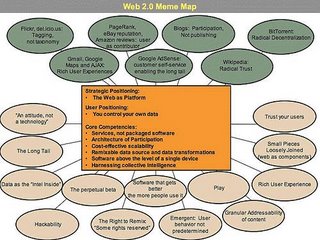Web 2.0 is really exciting! There are so many new features and applications showing up on web pages all over the world. I've been digging down into understanding what it is all about. I have tried to put together a small document about what Web 2.0 is all about, so here you go:
WEB 2.0
Web 2.0 is our generation's dot.com. It is not a technique, a product or a service. It is a concept, an established term that seeks to describe the latest and most progressive in web techniques. If a company of today starts calling itself something with "Web 2.0" for example 'Foto Web 2.0' it will instantly become more valuable. A web page or a web application being Web 2.0 means that it has one or several special properties. See more below for explanation, comparison and examples.
The term "Web 2.0" was introduced in october 2004 by O'Reilly at a conference in San Fransisco. Within weeks "Web 2.0" was an established term to describe the latest and most progressive in web techniques today.
According to O'Reilly's definition a web service should have the following properties to fit in as Web2:0
- The user should be able to contribute with data and mix and match information from different services.
- The user should have control over his/her information
- The design should look like ordinary desktop applications
To try to describe what Web 2.0 is, O'Reilly have with examples described differences between what we had or have today (web 1.0) and what now is coming more and more (web 2.0). Look at the table below:

10 commandments have been defined to describe Web 2.0:
- The web as a platform

- Services, not packaged software
- The perceptual beta
- The live web
- The long tail of the Internet
- Folksonomy
- Viral marketing & Syndication
- Hackable technologies & open API's
- Architecture of participation
- Rich Internet Applications
Web 2.0 is the network as platform, spanning all connected devices; Web 2.0 applications are those that make the most of the intrinsic advantages of that platform: delivering software as a continually-updated service that gets better the more people use it, consuming and remixing data from multiple sources, including individual users, while providing their own data and services in a form that allows remixing by others, creating network effects through an "architecture of participation," and going beyond the page metaphor of Web 1.0 to deliver rich user experiences.
References:
IDG
O'Reilly
Wikipedia
Some examples:
Link collections:







1 comment:
testing
Post a Comment